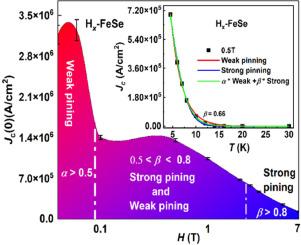H+互层 FeSe 单晶的通量动力学、Jc 各向异性和涡旋相图
IF 4.6
2区 物理与天体物理
Q1 PHYSICS, MULTIDISCIPLINARY
引用次数: 0
摘要
本文研究了质子化前后 FeSe 的超导性、钉扎和涡旋动力学。研究表明,质子化后,FeSe 的超导临界温度 Tc 提高到 40 K 以上,临界电流密度 Jc 也从 2.1 × 104 A/cm2提高到 1.2 × 106 A/cm2,磁弛豫速率 (Q) 明显增大。同时,临界电流密度各向异性(γ)大幅降低,而质子化后的上临界磁场 Hc2 从 13 T 增加到 91 T。此外,还探讨了 Hx-FeSe 中没有第二峰效应的原因。这项研究还揭示了质子化 FeSe 中存在与引脚行为相关的涡相转变,电阻率的脚状特征证明了这一点。基于这些结果,建立了质子化前后 FeSe 的涡旋相图。这些发现为通过质子化探索新型高温超导体及其磁通动态提供了重要见解。本文章由计算机程序翻译,如有差异,请以英文原文为准。

Flux dynamics, anisotropy in Jc and vortex phase diagram of H+-intercalated FeSe single crystal
This paper investigates the superconductivity, pinning, and vortex dynamics of FeSe before and after protonation. The study shows that, after being protonated, FeSe's superconducting critical temperature Tc has been increased to more than 40 K and the critical current density Jc has also been increased from 2.1 × 104 A/cm2 to 1.2 × 106 A/cm2, with significantly larger magnetic relaxation rates (Q). Meanwhile, the critical current density anisotropy (γ) decreases substantially while the upper critical field Hc2 increases from 13 T to 91 T after protonation. In addition, the reasons for the absence of the second peak effect in Hx-FeSe were explored. This investigation also reveals the existence of the vortex phase transition associated with the pinning behavior in protonated FeSe, demonstrated by the foot-like characteristics of resistivity. Based on these results, the vortex phase diagrams of FeSe before and after protonation were established. These findings provide important insights for exploring new high-temperature superconductors and their magnetic flux dynamics through protonation.
求助全文
通过发布文献求助,成功后即可免费获取论文全文。
去求助
来源期刊

Chinese Journal of Physics
物理-物理:综合
CiteScore
8.50
自引率
10.00%
发文量
361
审稿时长
44 days
期刊介绍:
The Chinese Journal of Physics publishes important advances in various branches in physics, including statistical and biophysical physics, condensed matter physics, atomic/molecular physics, optics, particle physics and nuclear physics.
The editors welcome manuscripts on:
-General Physics: Statistical and Quantum Mechanics, etc.-
Gravitation and Astrophysics-
Elementary Particles and Fields-
Nuclear Physics-
Atomic, Molecular, and Optical Physics-
Quantum Information and Quantum Computation-
Fluid Dynamics, Nonlinear Dynamics, Chaos, and Complex Networks-
Plasma and Beam Physics-
Condensed Matter: Structure, etc.-
Condensed Matter: Electronic Properties, etc.-
Polymer, Soft Matter, Biological, and Interdisciplinary Physics.
CJP publishes regular research papers, feature articles and review papers.
 求助内容:
求助内容: 应助结果提醒方式:
应助结果提醒方式:


